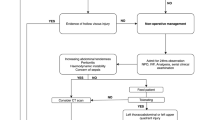Abstract
Purpose
A selective nonoperative management (SNOM) of penetrating abdominal injuries (PAI) is a standard of care in numerous established trauma centers. However, available evidence supporting SNOM of PAI in European settings remains scarce. Thus, we performed a multi-center study at selected Northern European trauma centers to investigate the management and outcomes of PAI. We hypothesized that despite a low number of penetrating injuries in included trauma centers, SNOM is successfully utilized with outcomes comparable with trauma centers with a high number of PAI.
Methods
All adult patients admitted to participating trauma centers in the Northern European region with PAI between 1/2015 and 12/2016 were retrospectively reviewed. Primary outcomes were mortality and success rate of SNOM.
Results
Overall, 119 patients were included. Median age was 38 (28–47) years. SNOM was initiated in 55 patients (46.0%) with 94.5% success rate. Three patients (5.5%) failed SNOM and had a delayed laparotomy with one gastric injury, one small bowel injury and one patient with a bleeding from mesentery. Overall mortality of the cohort was 5.0%. However, all patients in the SNOM group survived. Higher median ISS, median Abbreviated Injury Scale score of the abdomen, rate of combined anterior and posterior wounds, rate of in-hospital complications and longer hospital length of stay were observed in the immediate laparotomy group compared to the SNOM group.
Conclusions
SNOM of PAI is a safe practice even in regions with a low prevalence of penetrating injuries. The outcomes in our study are comparable with results from trauma centers treating larger numbers of patients with PAI.

Similar content being viewed by others
References
Nance FC, Cohn I Jr. Surgical judgment in the management of stab wounds of the abdomen: A retrospective and prospective analysis based on a study of 600 stabbed patients. Ann Surg. 1969;170(4):569–80.
Muckart DJ, Abdool-Carrim AT, King B. Selective conservative management of abdominal gunshot wounds: a prospective study. Br J Surg. 1990;77(6):652–5.
Demetriades D, Charalambides D, Lakhoo M, Pantanowitz D. Gunshot wound of the abdomen: role of selective conservative management. Br J Surg. 1991;78(2):220–2.
Navsaria PH, Nicol AJ, Edu S, Gandhi R, Ball CG. Selective nonoperative management in 1106 patients with abdominal gunshot wounds: conclusions on safety, efficacy, and the role of selective CT imaging in a prospective single-center study. Ann Surg. 2015;261(4):760–4.
Velmahos GC, Demetriades D, Toutouzas KG, Sarkisyan G, Chan LS, Ishak R, Alo K, Vassiliu P, Murray JA, Salim A, Asensio J, Belzberg H, Katkhouda N, Berne TV. Selective nonoperative management in 1,856 patients with abdominal gunshot wounds: should routine laparotomy still be the standard of care? Ann Surg. 2001;234(3):395–402 (discussion 402-3).
Al Rawahi AN, Al Hinai FA, Boyd JM, Doig CJ, Ball CG, Velmahos GC, Kirkpatrick AW, Navsaria PH, Roberts DJ. Outcomes of selective nonoperative management of civilian abdominal gunshot wounds: a systematic review and meta-analysis. World J Emerg Surg. 2018;27(13):55.
Dindo D, Demartines N, Clavien PA. Classification of surgical complications: a new proposal with evaluation in a cohort of 6336 patients and results of a survey. Ann Surg. 2004;240(2):205–13.
KDIGO. Acute kidney injury; 2012. https://kdigo.org/guidelines/acute-kidney-injury/. Accessed 2 June 2021.
Sander A, Spence RT, McPherson D, Edu S, Nicol A, Navsaria P. A prospective audit of 805 consecutive patients with penetrating abdominal trauma: evolving beyond injury mechanism dictating management. Ann Surg. 2020. https://doi.org/10.1097/SLA.0000000000004045.
Leppäniemi AK, Haapiainen RK. Selective nonoperative management of abdominal stab wounds: prospective, randomized study. World J Surg. 1996;20(8):1101–6.
Waes OV, Lieshout EV, Silfhout DV, Halm JA, Wijffels M, Vledder MV, Graaff H, Verhofstad M. Selective non-operative management for penetrating abdominal injury in a Dutch trauma centre. Ann R Coll Surg Engl. 2020;102(5):375–82.
Sander A, Spence R, Ellsmere J, Hoogerboord M, Edu S, Nicol A, Navsaria P. Penetrating abdominal trauma in the era of selective conservatism: a prospective cohort study in a level 1 trauma center. Eur J Trauma Emerg Surg. 2020. https://doi.org/10.1007/s00068-020-01478-y.
Peponis T, Kasotakis G, Yu J, Alouidor R, Burkott B, Maung AA, Johnson DC, Saillant N, Walden H, Salim A, Bryant E, Dorfman JD, Klein EN, Elefant R, Tabrizi MB, Bugaev N, Arabian SS, Velmahos GC. Selective nonoperative management of abdominal gunshot wounds from heresy to adoption: a multicenter study of the research consortium of New England Centers for Trauma (ReCoNECT). J Am Coll Surg. 2017;224(6):1036–45.
da Silva M, Navsaria PH, Edu S, Nicol AJ. Evisceration following abdominal stab wounds: analysis of 66 cases. World J Surg. 200;33(2):215–9.
Nagy K, Roberts R, Joseph K, An G, Barrett J. Evisceration after abdominal stab wounds: is laparotomy required? J Trauma. 1999;47(4):622–4 (discussion 624-6).
Kong VY, Weale R, Blodgett JM, Buitendag J, Bruce JL, Laing GL, Clarke DL. Laparotomy for organ evisceration from abdominal stab wounds: a South African experience. Injury. 2019;50(1):156–9.
Hajibandeh S, Hajibandeh S, Gumber AO, Wong CS. Laparoscopy versus laparotomy for the management of penetrating abdominal trauma: a systematic review and meta-analysis. Int J Surg. 2016;34:127–36.
Hughes M, Perkins Z. Outcomes following resuscitative thoracotomy for abdominal exsanguination, a systematic review. Scand J Trauma Resusc Emerg Med. 2020;28(1):9.
Funding
None.
Author information
Authors and Affiliations
Corresponding author
Ethics declarations
Conflict of interest
S. Saar, J. Jorgensen, A.N. Lemma, C. Gaarder, P.A. Naess, A. Leppäniemi, V. Sallinen, R. Pius, A. Reinsoo1, J. Lepp and P. Talving declare that they have no conflict of interest.
Ethical approval
All procedures performed in studies involving human participants were in accordance with the ethical standards of the institutional and/or national research committee and with the 1964 Helsinki declaration and its later amendments or comparable ethical standards.
Rights and permissions
About this article
Cite this article
Saar, S., Jorgensen, J., Lemma, A.N. et al. Selective non-operative management of penetrating abdominal injuries at Northern European trauma centers: the NordiPen Study. Eur J Trauma Emerg Surg 48, 2023–2027 (2022). https://doi.org/10.1007/s00068-021-01749-2
Received:
Accepted:
Published:
Issue Date:
DOI: https://doi.org/10.1007/s00068-021-01749-2




